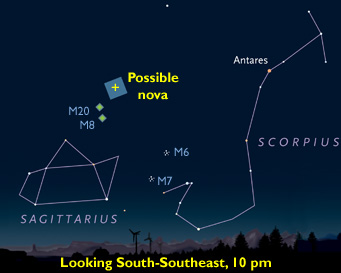A flaring star discovered independently by two Japanese observers has brightened to near 9th magnitude — putting it within easy range of most backyard telescopes.

A brightening star is obvious at center in this comparison of a red-light image taken last night (June 27.3 Universal Time) with an archived image from the Palomar Observatory Sky Survey. The field is 20 arcseconds wide.
E. Guido / G. Sostero / N. Howes
Observers are a-twitter with news that a likely nova has flared into prominence in northwest Sagittarius. Now nearing 9th magnitude, it's within reach of backyard observers with modest telescopes.
The star, designated PNV J17522579-2126215 by the IAU's Central Bureau for Astronomical Telegrams, was first reported yesterday by two independent observers. In Yamagata, Japan, Koichi Itagaki saw on images taken June 26th with an 8-inch reflector and CCD camera. A day earlier, Yukio Sakurai of Mito, Japan, had recorded it with his DSLR camera and a 180-mm telephoto lens.
Since then others have followed up with new observations. Initially reported at magnitude 10.2 by Itagaki, the star appears to have brightened a bit. Last night Ernesto Guido, Giovanni Sostero, and Nick Howes imaged the star remotely using a 20-inch telescope in New Mexico and determined that it had a red-light magnitude of 8.9.
Although fresh observations are streaming into the American Association of Variable Star Observers, astronomers are not yet ready to call this a true nova. László Kiss and others in Hungary took spectra using Gothard Observatory's 20-inch telescope but found no strong emissions lines. This suggests the outburst is from a low-intensity dwarf nova. But more results should determine its true nature.

A star situated just 2° from the Trifid Nebula (M20) flared to prominence in late June 2012. Click on the image to view or download a detailed finder chart that corresponds to the light-blue square.
Sky & Telescope diagram
Meanwhile, in order to see this flaring star, you'll need a clear view toward the south. It'll help if your light pollution isn't too bad. But try now if you can, because in a few days the nearly full Moon will bulldoze its way into this part of the sky.
The chart at right shows the general location of PNV J17522579-2126215, which is at right ascension 17h 52m 25.8s, declination –21° 26′ 21.6″. It's about 2° northwest of the Trifid Nebula (Messier 20) in a patch of sky relatively free of clutter from the Milky Way's star clouds. Click on the chart to reveal a detailed finder chart, which was provided to S&T by the AAVSO's Mike Simonsen.
 3
3









Comments
Richard Gargus
June 29, 2012 at 1:23 pm
Approxemately two weeks ago, I was on the phone to my sister, standing outside, looking at the night sky. I happened to scan the area of the current nova and saw a very bright, but very brief flash, and then it faded. I made a comment that this was a very unusual event, suggesting that it was perhaps a satelite reflecting sunlight, and also jokingly said maybe it was a super nova. Could I have seen a pre nova burst of energy? If so, it would have been a huge release of energy since it was for a short time, the brightest thing in the sky.
You must be logged in to post a comment.
Richard Gargus
June 29, 2012 at 1:23 pm
Approxemately two weeks ago, I was on the phone to my sister, standing outside, looking at the night sky. I happened to scan the area of the current nova and saw a very bright, but very brief flash, and then it faded. I made a comment that this was a very unusual event, suggesting that it was perhaps a satelite reflecting sunlight, and also jokingly said maybe it was a super nova. Could I have seen a pre nova burst of energy? If so, it would have been a huge release of energy since it was for a short time, the brightest thing in the sky.
You must be logged in to post a comment.
tom hoffelder
July 2, 2012 at 8:58 am
1. I'm quite certain the answer to the above question is no.
2. Regarding the POSSIBLE nova itself, since it has already dropped below 12th magnitude visually, I'm guessing it is not a "regular" nova.
You must be logged in to post a comment.
You must be logged in to post a comment.